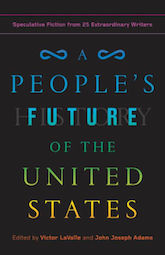A woman in New York City finds herself doomed to perpetually celebrate her early-mid-life birthday, cycling through the same rote interactions with friends and searching for a way to escape the pattern while struggling to convince anyone of what she’s going through. This describes the plot of the Netflix series Russian Doll, but it also encapsulates the essence of Alice Sola Kim’s short story “Now Wait for This Week,” which appears in Victor LaValle and John Joseph Adams’ anthology A People’s Future of the United States and bears striking similarities to the show.
In Russian Doll, the protagonist, Nadia, resurrects in the bathroom of her birthday party every time she dies, which usually doesn’t take more than a few hours; in Kim’s story, the narrator’s friend Bonnie finds herself reliving the same week over and over, ending up back at her birthday, death or no. Both narratives build to a breaking point in which repetition becomes its own transcendently powerful ritual; both feature women who, in their increasingly frenzied quest to convey the truth of their quandary to everyone else, endure a familiar cycle of trauma and gaslighting. Perhaps most crucially, both come to realize that they can’t move the fulcrum of their pocket universes alone: they’re not on a solitary hero’s journey, but one that requires collective action and a redefinition of what it means to descend into the labyrinth of the psyche and emerge intact.
Russian Doll unfolds in the dense urban maze of Manhattan, circling the streets around Tompkins Square Park as it traces the parallel paths Nadia takes night after exact same night. She searches for her lost cat; she helps a homeless man guard his shoes; she falls down stairs and into grates and encounters a dozen other fatal hazards of the city, all while navigating a reality with inscrutable rules that keep evolving. As the iterations progress, animals and objects and eventually people start to disappear from the reboots, emptying out the world Nadia knows so well, the neighborhood where she’s spent her entire life. The commentary on the real-life plight of the Lower East Side, where vacant storefronts dot the streets and beloved institutions seem to vanish every week, is clear enough, but the metaphor extends to the whole of contemporary consciousness: in a world where animals are really disappearing, where terrestrial realities we’ve long taken for granted are transforming, how long can the human mind hold out? As the end of the world starts to feel less like a bang or a whimper than a slow circling of the drain, the effort it takes to get through a month, a week, or a day feels ever more monumental, the pace of information sapping our ability and will to respond to anything but the most short-sighted concerns.
In Kim’s story, too, the recursive nature of the news cycle and of society’s set responses makes it impossible to step outside of time. The week that Bonnie keeps reliving is a week in which a popular celebrity is unmasked as an abuser, but when Bonnie records and uploads a video predicting his downfall, along with other details about the future, her foresight is ignored. “She insisted she had lived this week many times, listing off news of sex scandals and murderous police and mass shootings as if she were bringing precious communiques from the future and not just delivering the same old easy guesses absolutely anybody could make.” Time has collapsed in on itself, its linear progression lost in the unsettlingly routine loop of revelation, outrage, and eventual adaptation to new horrors that appear with every new week. Bonnie laments the way news of sexual harassment dominates the discussion at her cyclical birthday party—“Men men men men MEN. Can they not be the only subject of conversation left in the whole entire world please?”—and fears there’s no way it can continue on this way, that the span of time she’s reliving “is degrading and fraying in some intangible way and there will be devastating consequence. Like it’s going to just poop out. Can’t you feel it? The way everything feels so tired and busted and sad, and it’ll lurch forever but it also can’t go on like this forever?”
Buy the Book


Miranda in Milan
The feeling of being trapped in a grinding, broken system is one familiar to any marginalized person. If life is a video game, privileged white men tend to hoard all the cheat codes. Russian Doll’s Nadia is a video game designer whose colleagues are indistinguishable, condescending tech bros: so indistinguishable, in fact, that the actors playing them pop up as other characters in the series, harassing Nadia as Wall Street guys at a deli and strapping her into an ambulance as incompetent EMTs when she decides to commit herself to Bellevue. Always blithely unconcerned with anything else happening around them, they represent a distraction from Nadia’s quest at their best and a danger to her at their worst. Nadia’s mother has a history of mental illness that makes Nadia fear she’s losing her mind; Kim’s narrator had a schizophrenic aunt and is afraid of a future where no one believes a word she says. But that future has come to pass anyway: like so many other women, she finds her warnings about an abusive man she’s worked with go unheeded. He’s still at parties, still professionally and socially successful, still greeted with warmth by people who have heard and sympathized with her story. This continual gaslighting makes grappling with trauma all the more difficult, retriggering anxieties that it becomes more and more difficult to assuage. In a world where those outside of power structures are often called “crazy” for speaking their truth, seeking help for mental illness or personal cycles of addiction can feel especially fraught and potentially invalidating. Nadia detaches from herself and the people around her with the repeated use of drugs rather than seeking help; Bonnie’s friends have to use alcohol to let themselves speak freely about the terrible state of the mankind, walking back their comments with apologies and excuses in the sober light of morning.
Just like addiction, the time loop takes its toll on Nadia’s world: while things at first seem to reset to exactly the same state, it turns out certain objects—fruit, flowers—are decaying. But when Nadia slices open a moldy orange, she reveals the inside is bright and ripe: somewhere, in illo tempore, there’s a higher plane where everything is as it should be. Art is one of the forces that can transcend time, and it’s a recurring theme of Russian Doll. Nadia’s best friend Maxine is an artist who has built a giant glowing blue rift into her bathroom door, which may be a kind of axis mundi connecting the space where Nadia reboots to the banal reality of the party. In one version of said party, a pompous literature professor asks Maxine if she’s ever considered why visual art no longer carries the weight it did three decades ago. “The Internet,” pipes up a third character. “The AIDS crisis,” the professor refutes, citing its erasure of crucial critical voices across media. AIDS was indeed one of the cultural cataclysms that cleared the way for the rapid gentrification and development of areas like the Lower East Side, the disappearance of a community that many at the time refused to acknowledge was occurring. Nadia’s grandparents were survivors of the Holocaust, another wiping out of a people that was denied at the time, and denied by some to this day, even as its reverberating trauma remains with Nadia. But the Internet has helped create a multiplicative mirror universe where identifying objective truth becomes nigh impossible: images, facts, and histories can be altered and spread with unimaginable speed, making both Nadia and Bonnie’s search for their true timelines an exponentially difficult one.
This perhaps-futile quest echoes the narrative journey of Elizabeth Hand’s Cassandra Neary, who shares a name with the original victim of gaslighting, in the novel Generation Loss. Like Nadia, Cass is an addict and a relic of the lost Lower East Side. Her defining era was the punk epoch, when she achieved a fleeting measure of success as a photographer by documenting dead bodies in the city streets. In the decades since, she’s been trapped in a loop of her own: working at the Strand Bookstore, itself an iconic New York City labyrinth under constant threat of disappearance, and never managing to connect with anyone in any meaningful way, until she’s drawn out of the city on a mysterious interview assignment that takes her to an isolated island in Maine. Her subject is Aphrodite Kamestos, a cult figure whose legendary photos live on in shoddy reproductions, rendering null their original visceral impact and lending the book its evocative title. “Generation loss,” as Cass explains, is “what happens when you endlessly reproduce a photographic image. You lose authenticity, the quality deteriorates in each subsequent generation that’s copied from the original negative, and the original itself decays with time, so that every new image is a more degraded version of what you started with.”
What’s lost when this authenticity breaks down isn’t only an aesthetic quality: it’s a history, a vision. A perspective on the world from one particular person or from an entire generation, asserting that yes, we were here, and we witnessed this. This is how the world felt for us. In our kaleidoscopic reality, however, one where the parameters of perception itself shift from week to week, it can be hard enough to get a grip on one’s own personal history and place in the zeitgeist, let alone bear witness to anyone else’s. This witnessing is crucial, and the acknowledgement of trauma is central to the stories of Nadia, Bonnie, and Cass. Each woman undertakes a familiar monomythic journey to the center of the labyrinth of the self, excavating layers of perception to unearth the truths that will transform them. Joseph Campbell famously didn’t believe women could take the hero’s journey, because they were the goal of it, and few philosophers have dealt in depth with the midlife crises of people who aren’t men. But these are all midlife stories, stories of the cyclical contradictions of trauma. It’s hard to heal from history, personally or collectively, when history just keeps happening: but in failing to heal, we risk passing on trauma to new generations, of inflicting pain on others as pain was inflicted on us.
The renewal of self that provides the strength to surmount this considerable obstacle requires a return to origins, a revisiting of the site of the primordial schism, the defining trauma. Mircea Eliade’s work The Sacred and the Profane pops up throughout Generation Loss, providing the template for this labyrinthine odyssey, which must be made periodically throughout life: through ritual and repetition, it’s possible to access a mythical time that transcends concrete reality. This can take the form of EMDR therapy, like the kind Nadia’s surrogate mother Ruth practices in Russian Doll; it can take the form of mythmaking through art, like Nadia’s most beloved childhood book, Emily of New Moon, or like creating a video game. Russian Doll itself may be a kind of therapeutic simulation, one that requires players to face down their trauma before moving forward. Birthdays are a ritual with a direct connection to this time of beginnings: Nadia’s thirty-sixth birthday is particularly significant because it’s the age at which her mother died, just after Nadia feels she “betrayed” her by choosing a more stable home life with Ruth.
Buy the Book


A People's Future of the United States
Ultimately, the only way Nadia is able to progress is by releasing herself, and the little girl that she was, from her mother’s version of reality. Her mother not only manipulated Nadia into participating in her own skewed perception of the world: she forced her to convince others of its legitimacy, leaving Nadia without bearings as to what was real and unreal. Nadia’s belief that she’s damaged and her fears about passing this damage on to others manifest clearly in her repeated refusal to meet Lucy, the daughter of her ex-boyfriend, a decision that led to the end of that relationship. When she accepts that she wasn’t responsible for her mother’s death, after twenty-one repetitions of her own demise, she’s able to seek out Lucy and face her deepest fear. It’s this facing down of her demons that allows her to move on to the next level of the labyrinth, where she can support Alan, a character caught in a death-loop of his own, through his own cycle of trauma.
Cassandra Neary shares a similar arc in Generation Loss: her catalyst for change, and for involving herself in the world once again, is a young girl who needs her help, a young girl Cass initially ignores, caught up as she is in the cloud of her own trauma and substance abuse. Bonnie’s fate is more complex: initially she willfully ignores the trauma of her friends and society at large, her money and privilege insulating her against the direct attacks so many people she knows and hears about endure. She wants to maintain the status quo, which becomes her downfall. After countless cycles of the same week, she’s absorbed the rage of the people around her, the rage she sought for so long to deny, made all the more potent by the larger world’s refusal to believe her. “There’s a limit to how much I can improve all by myself,” she tells her friends, which is a key theme in all three stories. Solidarity is necessary to move forward. In Russian Doll, Nadia can’t save everyone in every timeline. Accepting the elements of chance that are intrinsic to mortality may be part of the quest, but realizing that her own fate is tied to others and effecting change accordingly is the central piece of the puzzle.
At the end of “Now Wait for This Week,” Bonnie sacrifices herself to let time progress, her exit all the more explosive for the gaslighting that’s gone on around her. Real change takes place in her wake: her acknowledgment of the truths she was ignoring and her choice to surrender the future she thought she deserved for the greater good has revolutionary power. Russian Doll closes with a corybantic parade, one where dancers don totemic animal masks, including a black bull reminiscent of the Minotaur, in the episode “Ariadne.” Are these the dead of the Wild Hunt, presaging upheaval and apocalypse as they pass? Or is this a celebration of the emergence from the underworld, of finding the way back to life?
The answers perhaps matter less than the mythmaking itself. Myths have always been humanity’s map, both a mirror and a guide to mortal concerns. New myths, positive or destructive, are created instantly these days, thanks to the power of technology and the ability to ignite a collective belief. But the way we make these myths matters, and these stories redefine the journey into the labyrinth as a collective effort, a pursuit of meaning that’s about moving beyond the narrow scope of one’s own individual timeline to recognize the multifarious truth of history and the present. At the close of “Now Wait for This Week,” the narrator literally holds the power to punish the abusive man who’s been haunting her in her hands, but what she wants from him with equal force is truth: the truth about what he did and why he did it, and his acknowledgment, his full realization, of the damage he’s done.
Bearing witness to each other’s vital truths, refusing to erase each others’ traumas, and taking action to protect and elevate one another while enduring time’s relentless effects on us and everyone we know is the recurrent struggle of a lifetime. Keeping the greater aims in sight while fighting one’s own battles and dealing with a new onslaught of pressing concerns every day is an immense difficulty, but it’s core to the higher consciousness of humanity. As Ruth puts it when Nadia asks her how she can possibly be okay with death and not okay with it at the same time: “Holding two incompatible ideas in your head at the same time and accepting both of them—that’s the best of being human.”
 Katharine Duckett’s fiction has appeared in Uncanny Magazine, Apex Magazine, Interzone, PseudoPod, and various anthologies. She is also the guest fiction editor for the Disabled People Destroy Fantasy issue of Uncanny. She hails from East Tennessee, has lived in Turkey and Kazakhstan, and attended Hampshire College in Amherst, Massachusetts, where she majored in minotaurs. Miranda in Milan is her first book.
Katharine Duckett’s fiction has appeared in Uncanny Magazine, Apex Magazine, Interzone, PseudoPod, and various anthologies. She is also the guest fiction editor for the Disabled People Destroy Fantasy issue of Uncanny. She hails from East Tennessee, has lived in Turkey and Kazakhstan, and attended Hampshire College in Amherst, Massachusetts, where she majored in minotaurs. Miranda in Milan is her first book.










